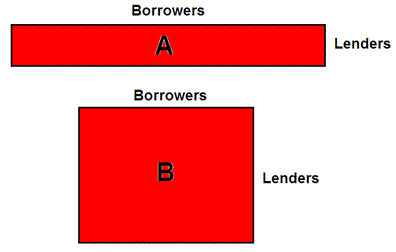Balancing Lenders and Borrowers is the Most Economically Stimulating
Economics / Economic Stimulus Sep 26, 2012 - 02:42 AM GMTBy: John_Handbury
Keeping interest rates low has always been perceived to be stimulating. This is based on the premise that borrowers are more inclined to borrow when rates are low. This is undeniably true, however, this simplification totally removes the lenders from the equation, which have an equal role in stimulation.
By definition the maximum activity (thereby stimulation) occurs when the number of borrowers is the same as the number of lenders. By definition this occurs at the MARKET PRICE. To artificially move rates either way from the market price suppresses either one group or the other and thereby de-stimulates.
Per Economics 101, the total activity of the market is the AREA of the number of sellers (Lenders) times the number of buyers (Borrowers) for any given price. The area of Rectangle A below, which has much more Borrowers than Lenders, is much smaller than Rectangle B, where the number of Borrowers and Lenders are equal at the market price.

Despite this, Central Banks have artificially lowered rates to essentially zero, and are taking steps such as Operation Twist to also lower longer term rates. Let’s be clear, no one is going to lend money to anyone at these measly interest rates, especially with the inherent risks in the market at this time. This is why banks are sitting on trillions of dollars of unused reserves. Central bankers are blaming the banks and corporations for not lending, but they are simply following risk-reward investing practices, which isn’t going to change for the next few centuries. If the rewards in terms of yields aren’t there, they ain’t gonna lend – end of story.
This premise cannot be any more evident than the last four years. Due to market shocks such as Lehman, the US Fed Fund Rate has been lowered to essentially zero to “stimulate” the economy. Over this time there has also been massive injections into the economy through deficit spending, TARP, bond-buying, and now MBS buying. You would think the market should be over-heating, in fact boiling. However we are still seeing the economy in the doldrums and unemployment remains high. This isn’t new - Japan went through the same process over the “lost decade” of the 1990’s where they lowered rates down to zero without seeing any improvement in the market, in fact just the opposite.
When Central Banks start lowering rates to “stimulate” the economy I (nearly) want to stand on the closest soapbox and yell out loud until they carry me away that what we’re inadvertently doing is DE-STIMULATING by suppressing liquidity and the desire to lend. What all Central banks should be doing right now is keeping out of the markets and allowing interest rates such as the Fed-Fund Rate to float up to the market price, which is by definition the most stimulating. Has this been done before? Yes, the Bank of England in the 18th and 19th centuries, and our own Federal Reserve during parts of the 20th, achieved stable world currencies and low interest rates - but not by managing interest rates. Their credible policies, centered upon currency stability, produced low costs of credit. The Fed can do the same in the 21st century.
John Handbury
Independent Trader
johnhandbury@hotmail.com
© 2012 Copyright John Handbury - All Rights Reserved Disclaimer: The above is a matter of opinion provided for general information purposes only and is not intended as investment advice. Information and analysis above are derived from sources and utilising methods believed to be reliable, but we cannot accept responsibility for any losses you may incur as a result of this analysis. Individuals should consult with their personal financial advisors.
© 2005-2022 http://www.MarketOracle.co.uk - The Market Oracle is a FREE Daily Financial Markets Analysis & Forecasting online publication.



